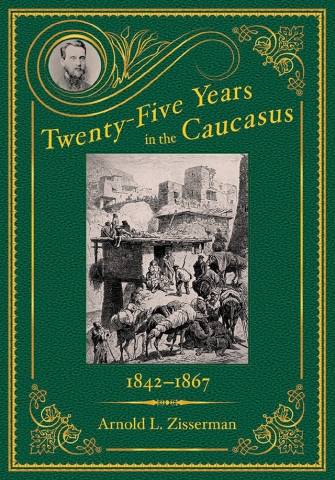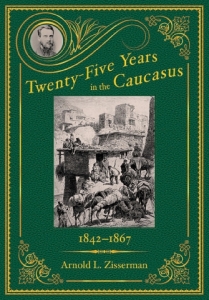Fresh Perspectives: A New Window on High-drama Caucasian History as Told by a Maker
Almost all visitors to Georgia (and its neighbors in the Caucasus) report having had a great time –truly hospitable people, great scenery, splendid food and wine, vibrant folklore, and exciting cultural and artistic life. But attempts to grasp even the outline of Georgian-Caucasian history – even recent history – pose problems. There’s too much of it: Imperial Russia invading in 1800; a Georgian republic in 1918-1921; Soviet occupation from 1921-1991; today’s new republic . . . And what about day-to-day events in Georgia and beyond; the lives of diverse peoples; the traditional cultures; and not least, the epic war Imperial Russian waged against the Muslim highlanders – in Azerbaijan, Chechnya, Dagestan? And where can a manageable account be found?
Truly readable narratives are few indeed – and almost all in Russian. J. F. Baddeley’s admired classic, The Russian Conquest of the Caucasus (1908), is a military history primarily covering the mid-1700s to 1859, when the Muslim guerilla leader Shamil surrendered; Baddeley’s ethnographically-oriented The Rugged Flanks of the Caucasus (1940) collects pioneering regional trips he made between 1898 and 1902. And, of course, Baddeley wrote as a visitor, not as a resident.
Is there any hope of finding a solid slice of superbly exciting, action-packed, high adventure in the Caucasus – a feet-on the-ground, I-was-there narrative, but in English? Yes, there is: with the publication of the two very engaging volumes of Twenty-Five Years in the Caucasus, 1842-1867, which the much-traveled Arnold Zisserman wrote during his retirement. They were published in Russian in 1879, but are now available in a first-time English translation – and they come with extras: 352 period illustrations, 17 maps, appendixes, bibliographies and indexes. No other work available in English is so far-ranging, vivid and rewarding as this near-encyclopediac account of a quarter-century of travel, war, danger and escape throughout the length and breadth of the Caucasus – from the Black to the Caspian Sea; from the snow-capped peaks of the Greater Caucasus to the hidden valleys of Dagestan.
But who was Zisserman? And why do his memoirs merit an English-language edition 122 years after their original publication? It’s simplest to say he was an exceptional young man who carved out a career as an administrator, military officer, strategist, explorer and ethnographer in the Caucasus, driven by his inherent qualities of imagination, curiosity, energy, courage, and competence. For the record, Arnold Zisserman, born in 1824 to a German émigré physician practising in Kamenets-Podolsky, in the then Russian province of Ukraine. At age 9 he became fascinated by military parades and soon thereafter – like Tolstoy and Turgenev – became an avid reader of the exiled Alexander Marlinsky’s highly colorful tales of life in the exotic Caucasus. During his 17th year he applied for a government job in the seething multicultural Eurasian city of Tbilisi (Tiflis to the Russians) – and before his 18th birthday made the exhausting 2000 km stagecoach journey to begin unhappily clerking away in the Imperial government’s dreary Office of Abandoned Property.
In 1843, at 19, Zisserman secured the post of an assistant to Prince Mikheil Cholokashvili, administrator of the Eastern Georgian region centered on Tianeti, which included the remote deep-rural Tushin-Pshav-Khevsur districts, located high in the challenging Greater Caucasus range. He was the ideal deputy: the prince enjoyed visiting and feasting, leaving his young assistant to administer justice, settle disputes among nobles, and ride out with the militia against raiding highlanders – even supervising construction of the first wheeled-vehicles road from Tianeti to Tbilisi, opening up the region to trade and prosperity. Zisserman worked hard to learn fluent Georgian and also began making notes on highly traditional local life, particularly that of the highlanders, while also recording the often horrific events of the drawn-out Russian-Muslim war, in which the great guerrilla leader Shamil led the highlanders.
In 1846 Zisserman had a fortunate meeting with the farsighted and liberal Prince Voronstov, Viceroy of the Caucasus, when he provided a simultaneous translation into Georgian of a speech the latter was delivering in Russian. Vorontsov recognized Zisserman’s intelligence and – despite an immense difference in background and rank – became a well-disposed supporter of the younger man.
Unfortunately, Prince Cholokashvili died in 1847, and his successor was hostile to Zisserman, making his life as hard and office-bound as possible. Nonetheless Zisserman engineered long absences in the field, surviving many adventures, variously reconnoitering mountain routes, meeting makers and shakers in Tbilisi, and exploring Pshavi, Khevsureti and Tusheti in the remote and rugged mountainous northeast, where he carefully compiled important ethnographic notes. He also gave much thought – and made many incisive comments – on the conduct of the Russian-Caucasian war, and Shamil’s strategies and tactics. His gifts of acute observation, of capturing personalities (particularly those of obnoxious and misguided senior military officers) and incisive reporting shine through his memoirs. Above all, Zisserman is far from being any sort of official propagandist: he is at times critical of the platitudes about Imperial Russia’s mission civilisatrice.
In 1848 Zisserman secured a new job, that of police-chief in the dangerous Sultanate of Elisu, in Azerbaijan, where his predecessor had been killed in action against the Muslim highlanders. In his new post Zisserman was now fully embroiled in an unending Russian campaign to crush Muslim resistance to the occupation of their lands. Though events – most of them better termed adventures – followed thick and fast, with Muslim raids, field expeditions, meetings with generals and with Viceroy Vorontsov among them. Finally, with the personal help of well-placed Georgian generals and that of the Viceroy himself, Zisserman achieved his greatest ambition: Emperor Nicholas I commissioned him as a military officer. For a civilian of modest birth – despite pioneering achievements and action in the field and subsequent awards – this was an almost unheard-of transition.
Service in the Dagestan Infantry Regiment gave Zisserman a broader canvas of experience to survey and record in his unique memoir. In every way, the Russian Army was a world unto itself, distinctly different to and deemed by many to be superior to the civilian world; it saw itself not only as the sword and shield of the sacred Tsar, but as the very bedrock and sustaining force of the Russian Empire – the key to Russia’s standing among nations. The Army of the Caucasus saw itself as even more prestigious and privileged – and the engaging tales of Marlinsky, Lermontov and Tolstoy added glamor.
A number of Russian generals wrote their memoirs, with different degrees of propagandistic strutting and self-justification, inflating the numbers of Muslim highlanders killed and minimizing Russian losses – and also the immense collateral destruction wreaked on highlanders’ families, children and food sources. Zisserman is virtually unique in describing the abilities and characters of generals (Bariatinski, Evdokimov, Muraviev, Vorontsov, Vrevsky, Wrangel and Yermolov among them), and provides human detail not found elsewhere. Even more importantly he writes of the Georgian and Caucasian-born generals – Andronikov, Argutinski-Dolgoruki, Bebutov, the Chavchavadzes, Eristov, the Orbelianis and others.
Zisserman also provides insightful portraits of Imam Shamil who, leading some 12,000 to 20,000 Muslim highlanders, held down c. 200,000 Russians for 30 years while operating in regions as distant as southern Dagestan and Chechnya. His thoughtful assessments of Shamil and Hadji Murad in part run counter to the received pictures – and it is of interest that Tolstoy consulted with Zisserman when writing his great novella Hadji Murad.
What adds depth, breadth and value to Zisserman’s narrative is the extent to which it captures the human (sometimes scarcely human) aspects not only of army life in forts and on campaign but also of ordinary Caucasian life, whether in the mountains or on the plains; whether at weddings and funerals, festivals and feasts or during feuds. Zisserman is rightly recognized as an acutely observant though not professionally trained ethnographer – and his accounts are often cited by later experts. Throughout Zisserman’s text the reader feels he is present, whether on a razor-sharp ice-clad ridge during a blizzard, on the plains in scorching heat, crossing torrential rivers, or standing guard in the field, ever-alert for midnight raiders. Readers travel far beyond Georgia, accompanying Zisserman on arduous journeys into turbulent Chechnya, into war-torn Ossetia (where he optimistically built churches) and into still untamed Dagestan – and they benefit from a useful ethnohistorical introduction to these frontier regions.
Zisserman also describes relaxing side-trips in Georgia to Tbilisi and to Imereti and Kutaisi (where he escorted the future Tsar Alexander II), to the Caspian Sea and historic Derbend, to Vladikavkaz and on to the fashionable spa towns of Pyatigorsk and Kislovodsk in Russia’s North Caucasus region. Nor is the reader denied knowledge of what filled the literary and news journals that arrived belatedly from Russia or the social life of the officers’ mess, which ran to banquets, even theatrical performances and much horseplay – to say nothing of episodes of neurotic excess from chronically alcoholic or clinically depressed officers.
Zissserman is a sane, sober but critical observer of a great contest: imperial might vs the Caucasians’ inextinguishable yearning for independence. We are fortunate to have his ever-colorful account and unique insights.
Twenty-Five Years in the Caucasus, 1842-1867, by Arnold L. Zisserman
(2 Vols with 352 added illustrations and 17 maps) will soon be available at Prospero’s Bookshop, 34 Rustaveli Avenue.
By Peter Skinner











